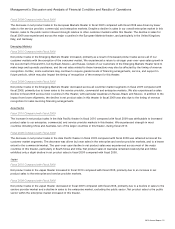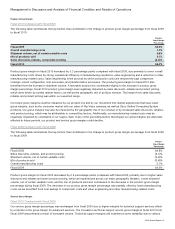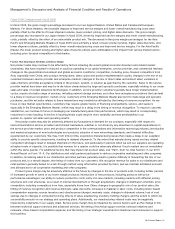Cisco 2010 Annual Report Download - page 29
Download and view the complete annual report
Please find page 29 of the 2010 Cisco annual report below. You can navigate through the pages in the report by either clicking on the pages listed below, or by using the keyword search tool below to find specific information within the annual report.
Management’s Discussion and Analysis of Financial Condition and Results of Operations
G&A Expenses
Fiscal 2010 Compared with Fiscal 2009
The increase in G&A expenses in fiscal 2010 compared with fiscal 2009 was in part attributable to approximately $130 million of
higher real estate-related charges related to impairments and other charges related to excess facilities. Additionally, G&A expenses
in fiscal 2010 increased due to higher share-based compensation expense, higher headcount-related expenses, acquisition-
related expenses, and higher information technology expenses, as well as the impact of the extra week in fiscal 2010.
Fiscal 2009 Compared with Fiscal 2008
The increase in G&A expenses in fiscal 2009 compared with fiscal 2008 was primarily due to increased project-related expenses,
including information technology expenses. Other factors also contributed to the increase in G&A expenses in fiscal 2009, including
higher share-based compensation and acquisition-related compensation expenses, as well as the enhanced early retirement and
limited workforce reduction charges in fiscal 2009.
Effect of Foreign Currency
In fiscal 2010, foreign currency fluctuations, net of hedging, increased the combined R&D, sales and marketing, and G&A expenses
by $34 million, or approximately 0.2%, compared with fiscal 2009. In fiscal 2009, foreign currency fluctuations, net of hedging,
decreased the combined R&D, sales and marketing, and G&A expenses by approximately $280 million, or 1.8%, compared with
fiscal 2008.
Headcount
Fiscal 2010 Compared with Fiscal 2009
For fiscal 2010, our headcount increased by approximately 5,150 employees, which was attributable to the acquisitions of
Tandberg and Starent along with targeted hiring as part of our investment in growth initiatives. We expect to increase our
headcount in the near term based on what we believe to be a positive market for our growth initiatives, and in addition to hiring in
order to capitalize on such initiatives, our hiring will be focused on productivity improvements and movements into new market
adjacencies.
Fiscal 2009 Compared with Fiscal 2008
Our headcount decreased by 584 employees in fiscal 2009. The decrease in headcount in fiscal 2009 resulted from our limited
workforce reduction actions, employee attrition, and a hiring pause. The decrease was partially offset by the effect of acquisitions
and the hiring of recent college graduates.
Share-Based Compensation Expense
The following table presents share-based compensation expense (in millions):
Years Ended July 31, 2010 July 25, 2009 July 26, 2008
Cost of sales—product $57 $46 $40
Cost of sales—service 164 128 108
Share-based compensation expense in cost of sales 221 174 148
Research and development 450 382 339
Sales and marketing 536 441 438
General and administrative 310 234 187
Share-based compensation expense in operating expenses 1,296 1,057 964
Total share-based compensation expense $ 1,517 $ 1,231 $ 1,112
Share-based compensation expense increased for fiscal 2010 compared with fiscal 2009 due primarily to the effects of straight-line
vesting compared with accelerated vesting for options granted prior to fiscal 2006, a change in vesting periods from five to four years
for awards granted beginning in fiscal 2009, and the impact of the extra week in fiscal 2010. Share-based compensation expense for
fiscal 2009 increased compared with fiscal 2008, primarily due to a larger proportion of share-based awards being subject to straight-
line vesting, a shorter vesting period of four years for most share-based awards granted in fiscal 2009, and an increase in the weighted-
average estimated grant date fair value for each share-based award. See Note 13 to the Consolidated Financial Statements.
2010 Annual Report 27
























